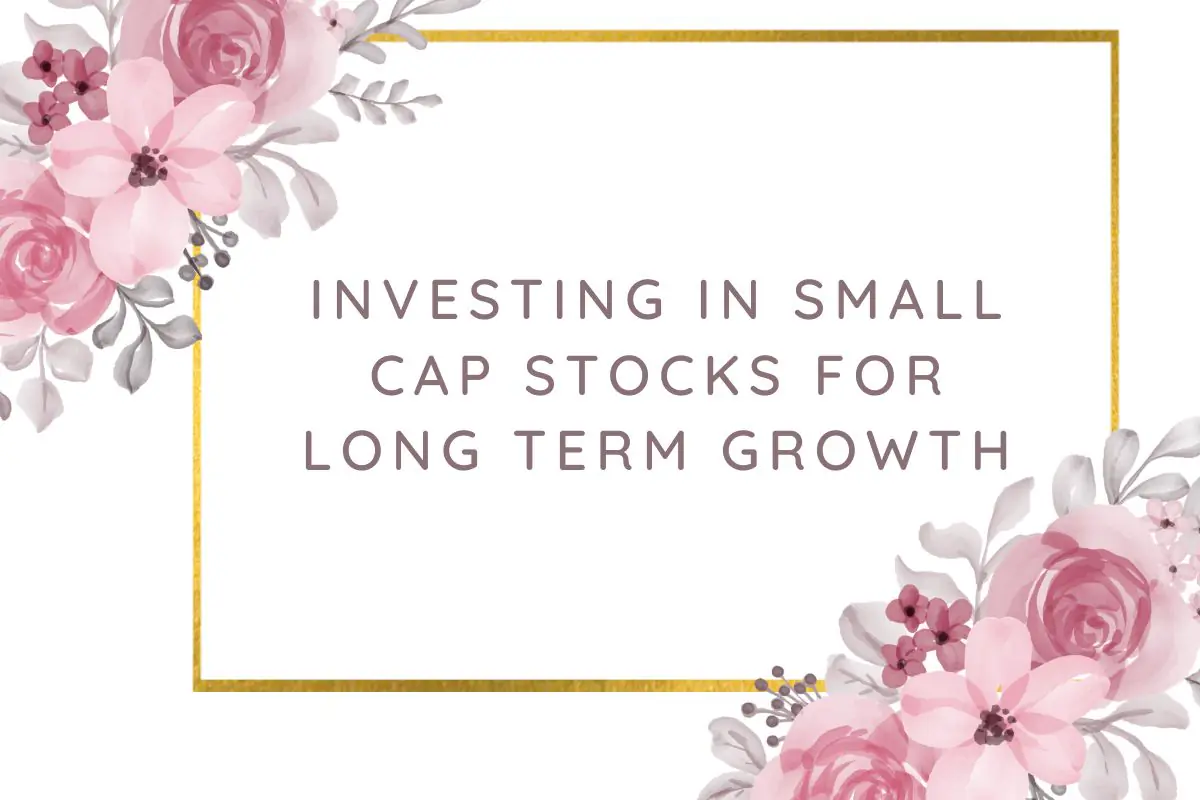Investing In Small Cap Stocks For Long Term Growth Investing in small cap stocks for long-term growth can be an exciting yet challenging journey for investors seeking higher returns. Small cap stocks, characterized by smaller market capitalizations, offer unique opportunities for growth and outperformance, but also come with inherent risks and volatility.
In this article, we will explore the world of small cap investing, discussing the benefits, risks, strategies for selection, key metrics for evaluation, and best practices for building a successful small cap portfolio geared towards long-term growth and wealth accumulation.
Introduction to Investing In Small Cap Stocks For Long Term Growth
Investing In Small Cap Stocks For Long Term Growth Small cap stocks may sound like something out of a theme park for financial enthusiasts, but they are actually just stocks of small companies. These little guys can potentially pack a big punch in your investment portfolio. Let’s dive into the world of small cap stocks and see what they’re all about.
Defining Small Cap Stocks
Investing In Small Cap Stocks For Long Term Growth In the land of stock market lingo, small cap stocks refer to companies with a relatively small market capitalization. In simpler terms, these are companies with a total value (number of shares multiplied by their price) that falls on the lower end of the stock market spectrum.
Historical Performance of Small Cap Stocks
Investing In Small Cap Stocks For Long Term Growth Small cap stocks have a history of being like that hidden gem you find in a thrift store – overlooked but full of potential. Over the years, these little dynamos have shown the ability to outperform their larger counterparts. Their growth trajectory can make them an exciting addition to your investment mix.
Benefits of Investing in Small Cap Stocks

Investing In Small Cap Stocks For Long Term Growth When it comes to small cap stocks, think of them as the underdog with a lot of fight in them. Here are some reasons why these pint-sized powerhouses can bring a lot to your investment table.
Potential for High Growth
Investing In Small Cap Stocks For Long Term Growth Small cap stocks have a reputation for being the high-energy, high-growth players in the stock market game. Their size allows them to quickly adapt to changing market conditions, potentially leading to rapid growth and juicy returns for investors.
Outperformance Potential
Investing In Small Cap Stocks For Long Term Growth Don’t let their small stature fool you – small cap stocks have shown a tendency to outperform larger companies over the long term. Their nimbleness and ability to seize opportunities can result in healthy returns for investors who dare to venture into this exciting territory.
Before you get too starry-eyed about the potential of small cap stocks, it’s important to acknowledge the flip side of the coin. Here are some risks and challenges that come with investing in these mini marvels.
Volatility and Market Fluctuations
Investing In Small Cap Stocks For Long Term Growth Small cap stocks can be like that rollercoaster ride you can’t decide if you love or hate. Their prices can swing wildly in response to market conditions, economic news, or even just a change in the weather. Buckle up and be prepared for a bumpy ride.
Liquidity Risks
Investing In Small Cap Stocks For Long Term Growth Unlike their larger counterparts, small cap stocks may have lower trading volumes, which can make it harder to buy or sell shares quickly without affecting the price. This lack of liquidity can sometimes lead to challenges in exiting positions when you need to.
Strategies for Selecting Small Cap Stocks
Investing In Small Cap Stocks For Long Term Growth Now that you’re ready to dip your toes into the world of small cap stocks, it’s essential to have a game plan. Here are some strategies to help you navigate the exciting, yet sometimes treacherous waters of small cap stock investing.
Bottom-Up vs. Top-Down Approach
Investing In Small Cap Stocks For Long Term Growth When it comes to selecting small cap stocks, you can take a bottom-up approach by analyzing individual company fundamentals or a top-down approach by looking at broader economic trends. Mix and match these approaches to find the winning formula that works for you.
Value vs. Growth Investing
Investing In Small Cap Stocks For Long Term Growth Do you prefer your stocks like fine wine, growing better with age (value investing), or are you more of a fast and furious, high-growth aficionado (growth investing)? Small cap stocks offer opportunities for both styles, so pick your poison and get ready for an exhilarating ride.
Factors Influencing Long-Term Growth Potential
Investing In Small Cap Stocks For Long Term Growth Investing in small-cap stocks for long-term growth requires a keen understanding of various factors that influence their potential success. Market trends and industry analysis play a crucial role in determining the growth trajectory of small-cap companies. Additionally, evaluating company fundamentals and management strength is essential in identifying firms with sustainable growth prospects.
Key Metrics to Evaluate Small Cap Stocks
Investing In Small Cap Stocks For Long Term Growth When considering small-cap stocks for long-term investment, key metrics can provide valuable insights. The price-to-earnings (P/E) ratio helps assess a stock’s valuation relative to its earnings potential, while the debt-to-equity ratio reveals a company’s financial leverage and solvency levels.
Building a Diversified Small Cap Portfolio
Diversification is key when constructing a portfolio of small-cap stocks for long-term growth. Allocating investments across different sectors helps mitigate risks associated with sector-specific downturns. Implementing effective risk management strategies further safeguards the portfolio against unforeseen market fluctuations.
Best Practices for Long-Term Success
To ensure long-term success in small-cap investing, monitoring and rebalancing your portfolio regularly is essential. Staying informed about market developments and adapting to changes swiftly can help capitalize on emerging opportunities and navigate challenges effectively. Remember, flexibility and informed decision-making are integral to achieving sustained growth in small-cap investments.
In conclusion, investing in small cap stocks can be a rewarding strategy for long-term growth, provided investors are willing to navigate the risks and challenges effectively. By understanding the factors influencing small cap performance, utilizing key metrics for evaluation, and implementing sound portfolio management practices, investors can position themselves for success in the dynamic world of small cap investing. Remember, patience, diligence, and a long-term perspective are essential for harnessing the growth potential of small cap stocks and achieving your investment goals.
FAQs
What exactly are small cap stocks and how do they differ from other types of stocks?
These companies are smaller in size compared to large cap and mid cap companies. Small cap stocks often exhibit higher growth potential but also tend to be riskier and more volatile. Unlike large cap stocks, which are generally well-established companies with stable earnings and market presence, small cap stocks may be newer, less known, and more susceptible to market fluctuations.
Are small cap stocks more volatile than large cap stocks?
Yes, small cap stocks are generally more volatile than large cap stocks. Due to their smaller size and lower liquidity, small cap stocks are more sensitive to changes in market conditions, investor sentiment, and company-specific news or events. This increased volatility can lead to larger price fluctuations and higher levels of risk for investors. However, it’s important to note that while small cap stocks may experience greater short-term volatility, they also have the potential to deliver higher returns over the long term.
How can investors mitigate the risks associated with investing in small cap stocks?
Investors can mitigate the risks associated with investing in small cap stocks by:
Diversifying their investment portfolio across different asset classes, sectors, and market capitalizations to spread risk.
Conducting thorough research and due diligence on small cap companies before investing, including analyzing financial statements, growth prospects, competitive positioning, and management quality.
Setting realistic investment goals and time horizons, as small cap stocks may require a longer investment horizon to realize their full growth potential.
Implementing risk management techniques such as setting stop-loss orders or using position sizing to limit potential losses.
Staying informed about market trends, economic developments, and regulatory changes that may impact small cap stocks.
What are some key strategies for selecting small cap stocks with long-term growth potential?
Some key strategies for selecting small cap stocks with long-term growth potential include:
Identifying companies with strong fundamentals, including solid revenue growth, earnings potential, and sustainable competitive advantages.
Looking for small cap stocks in industries or sectors poised for growth, such as technology, healthcare, or renewable energy.
Paying attention to company management and leadership, as competent and experienced management teams can drive long-term value creation.
Considering factors such as innovation, market opportunity, and scalability when evaluating small cap stocks for their growth potential.
Being patient and disciplined in holding onto investments, as successful small cap investing often requires a long-term perspective and willingness to ride out short-term volatility.

